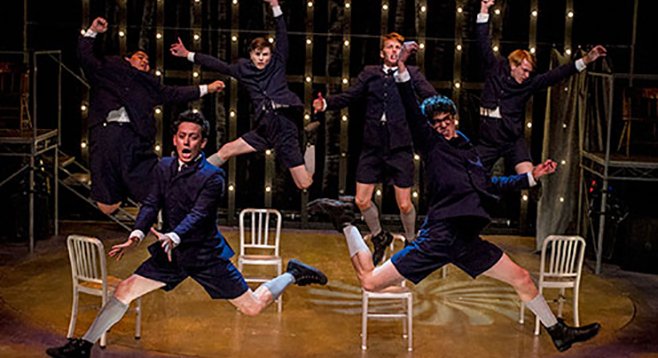 Facebook
Facebook
 X
X
 Instagram
Instagram
 TikTok
TikTok
 Youtube
Youtube

Mark Rothko and his fellow Abstract Expressionists (though they didn’t like the name) battered the Cubists to pulp. Now, as Rothko contemplates what could be his masterpiece — and the place to showcase his special gifts — here comes a generation of upstarts, the Pop Artists, to shred him, Jackson Pollock, William DeKooning and the other, over the hill dinosaurs.
John Logan’s five-scene drama puts us inside the head of a genius. Or is he? Where will he fit in the Great Chain of Masters? Up there with Rembrandt? Or will paintings of soup cans erase his oeuvre?
And is his contract to paint murals for a chic, swa-swa restaurant, the Four Seasons, a sell-out?
As in Amadeus, where Mozart teaches Salieri about music, Red includes an ongoing master class on art appreciation — and an insistence that today’s artists and audiences get serious for once. In effect, the script makes us Salieri to Rothko’s Mozart.
As Rothko, John Vickery releases the turmoil of a mind near, on, or over-the-hill, and the death-haunted subtext below (his greatest fear: the “absence of red”). Jason Maddy, as his apprentice Ken, learns, grows, and just may become the artist he aspires to be.
Word has it that when Duncan Sheik, who wrote the music for the eight-time Tony Award-winner (2006), caught Cygnet Theatre’s production, he declared it the finest regional version he’d seen.
Talk like that could either be true, or hype (as in “I bet you tell that to every regional version”). In any case, whether or not Mohammed moved that mountain, or it was just PR, Cygnet’s is the best staging San Diego has seen — there have been three or four others — and most likely will see.
Spring is a hybrid. It takes place over 100 years ago and today. Repressed teens confront puberty with no sex education. Then they grab a mic and give voice to their pain and perplexity like rock stars. As they belt out songs, their bodies contort and splay, as if suddenly set free from solitary confinement.
After a song, however, it’s as if the prissy, lock-step culture sucks them back in. They had a moment of release. Now the pressure builds again.
And brings some closer to tragedy.


Mark Rothko and his fellow Abstract Expressionists (though they didn’t like the name) battered the Cubists to pulp. Now, as Rothko contemplates what could be his masterpiece — and the place to showcase his special gifts — here comes a generation of upstarts, the Pop Artists, to shred him, Jackson Pollock, William DeKooning and the other, over the hill dinosaurs.
John Logan’s five-scene drama puts us inside the head of a genius. Or is he? Where will he fit in the Great Chain of Masters? Up there with Rembrandt? Or will paintings of soup cans erase his oeuvre?
And is his contract to paint murals for a chic, swa-swa restaurant, the Four Seasons, a sell-out?
As in Amadeus, where Mozart teaches Salieri about music, Red includes an ongoing master class on art appreciation — and an insistence that today’s artists and audiences get serious for once. In effect, the script makes us Salieri to Rothko’s Mozart.
As Rothko, John Vickery releases the turmoil of a mind near, on, or over-the-hill, and the death-haunted subtext below (his greatest fear: the “absence of red”). Jason Maddy, as his apprentice Ken, learns, grows, and just may become the artist he aspires to be.
Word has it that when Duncan Sheik, who wrote the music for the eight-time Tony Award-winner (2006), caught Cygnet Theatre’s production, he declared it the finest regional version he’d seen.
Talk like that could either be true, or hype (as in “I bet you tell that to every regional version”). In any case, whether or not Mohammed moved that mountain, or it was just PR, Cygnet’s is the best staging San Diego has seen — there have been three or four others — and most likely will see.
Spring is a hybrid. It takes place over 100 years ago and today. Repressed teens confront puberty with no sex education. Then they grab a mic and give voice to their pain and perplexity like rock stars. As they belt out songs, their bodies contort and splay, as if suddenly set free from solitary confinement.
After a song, however, it’s as if the prissy, lock-step culture sucks them back in. They had a moment of release. Now the pressure builds again.
And brings some closer to tragedy.
Comments